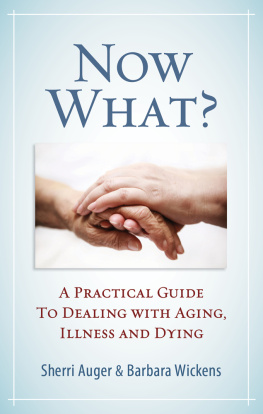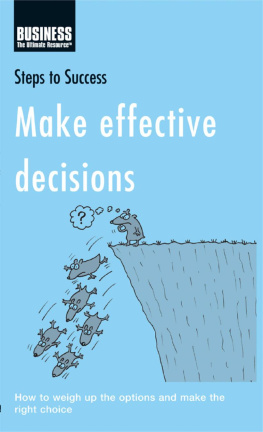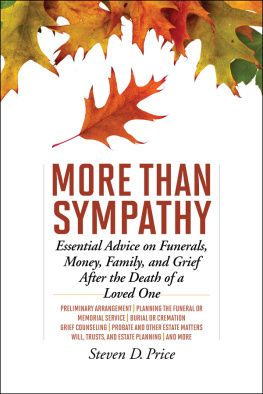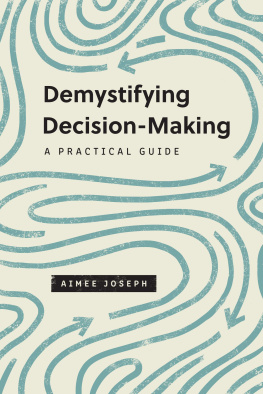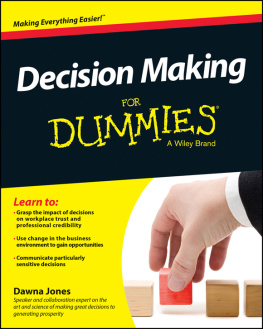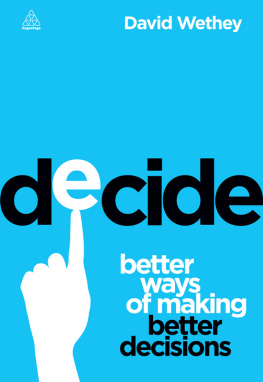Now What?
Now What?
A Practical Guide to Dealing with Aging, Illness and Dying
Sherri Auger and Barbara Wickens
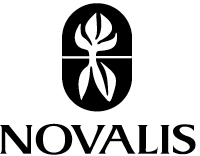
2010 Novalis Publishing Inc.
Cover design: Blair Turner
Layout: Audrey Wells
eBook development: WildElement.ca
Published by Novalis
Publishing Office
10 Lower Spadina Avenue, Suite 400
Toronto, Ontario, Canada
M5V 2Z2
Head Office
4475 Frontenac Street
Montral, Qubec, Canada
H2H 2S2
www.novalis.ca
Library and Archives Canada Cataloguing in Publication
Auger, Sherri, 1964-
Now what? : a practical guide to dealing with aging, illness,
and dying / Sherri Auger and Barbara Wickens.
ISBN 978-2-89646-217-9
1. Aging parents--Care--Canada. 2. Adult children of aging
parents--Family relationships--Canada. 3. Parents--Death.
I. Wickens, Barbara, 1953- II. Title.
HQ1063.6.A94 2010 306.874 C2010-901271-2
Printed in Canada.
Disclaimer
Now What? A Practical Guide to Dealing with Aging, Illness and Dying provides general information on a range of financial, legal and medical topics. The recommendations made in this book are generic and are not meant to replace advice from the appropriate expert familiar with your unique circumstances. If you need assistance or counselling, seek the advice and guidance of a trustworthy professional.
All rights reserved. No part of this publication may be reproduced, stored in a retrieval system, or transmitted in any form, or by any means, electronic, mechanical, photocopying, recording, or otherwise, without the written permission of the publisher.
We acknowledge the financial support of the Government of Canada through the Book Publishing Industry Development Program (BPIDP) for our publishing activities.
5 4 3 2 1 14 13 12 11 10
Dedicated to our parents,
Margaret and David Savage
and
Marion and William Wickens,
without whom this book would not have been written.
Acknowledgements
O ur thanks to Novalis, and Joseph Sinasac, for agreeing to publish our book.
Arnold Gosewich, our literary agent, for believing in our idea.
Our friends Cheryl Hawkes, Susan McLennan and Deborah Moskovitch, for bringing the various parties together.
We would also like to acknowledge and thank all those who so generously shared their time and expertise with us. Frank Jannetta, Todd Milks, Catherine Hilge, Lorraine Joynt, Fred Devellano, Paul C. Nazareth, John Murphy, Len Chapman, Rick Firth and Gary Campbell all helped shape our thinking. Our thanks go to those whom we do not name for sharing their stories. You know who you are and how much you contributed.
Sherri would like to thank her loving husband, Alex, for his unwavering support and encouragement; her families, both her own and her clients, for sharing their life experiences; and Lindsey, for always being there. A special thanks to Ute, Carole, Peter and Anne, for sharing their stories and letting others benefit from their wisdom and life lessons.
Barbara would like to thank her sister, Marilyn, brother-in-law, David, and their son, Graham, for their support, inspiration and wise words. She also wishes to thank her great friends Holly, Deb, Lisa, Barb, Julie and Tom. You helped in more ways than you will ever know.
Table of Contents
Introduction
Y our 89-year-old mother is very proud of the fact that she still lives on her own. Yet the last few times you visited her, you noticed shes no longer as meticulous about her personal grooming as she once was. More troubling, you discovered a glowing hot kitchen stove element shed left on for hours.
Now what?
The diagnosis is what youd both been dreading and its devastating. Your spouse has cancer and only three to six months to live.
Now what?
Besides a few minor aches and pains and a chronic condition you keep under control, your overall health is pretty good. Still, you take a clear-eyed look at yourself, knowing the road ahead is a lot shorter than the road youve already travelled.
Now what?
The funeral is over. Friends have resumed their daily lives. Your adult children stayed as long as they could, but now theyve returned home to their own families 2,000 miles away. The house suddenly seems very, very empty.
Now what?
*
Now what? Its the question we ask when we cant even imagine where to turn or what to do next. The answer we get will depend on whom we ask. Eldercare specialists can assess whether a seniors problems are mental, physical or both, sort out assistance they may need to continue living on their own, and the best living arrangements for them if they cant. Doctors, nurses, and other health-care professionals will guide you through the medical treatment and palliative care options that are available. A pastor can make sure that those who are ill or dying receive sacraments that reflect and nourish their faith. Lawyers, accountants and financial advisers can help you write a will and devise an estate plan. Some funeral service providers will walk you through the steps involved in wrapping up an estate.
Thank goodness all these professionals are here to help. As the world grows ever more complex, we need people with specific areas of expertise to help us make the best possible decisions about things we know little or nothing about. Not making a decision is not an option.
Each of those specialists, however, deals with only one piece of the whole fabric of our lives. What if we have to deal with several challenges at once? How do we know what requires our immediate attention and what can wait? In fact, how do we even know what we need to know?
Under normal circumstances, many of us can eventually figure out how to climb a steep learning curve that has appeared in our path. But death, whether the result of disease, a traumatic accident or even the natural decline of old age, no longer seems a normal event in our lives.
Certainly death appears to be all around us. We get daily news updates on the carnage resulting from the latest natural and human-made disasters. Television programs, movies and video games show death in vivid detail.
Nothing we have seen on any screen, however, can prepare us for the reality of death. The first time someone close to us is diagnosed with a terminal illness or dies, we may be shocked by the surge of emotions and confused thoughts that sweep over us. Such intense sensations can feel even more overwhelming when they are unexpected.
For those who believe that their earthly life is only part of the journey, a terminal prognosis can be bittersweet. Believing in eternal life means physical death is not an end but a change. Still, it is not always easy for the flesh to bear that change, even as the spirit prepares for the next step of the journey. Earlier generations were probably no more eager to think about death, let alone discuss it with family or friends, than we are today. Its human nature, after all, to avoid anything so inherently unpleasant. Still, the very real presence of death in the midst of everyday life made the subject unavoidable. At the turn of the last century, Grandpas body would have been laid out in the parlour for visitors to pay their respects. Grieving family and friends went to the cemetery where they watched as the coffin was lowered into the ground. Wearing a black armband was a signal to others that you were in mourning. Without such tangible reminders, its easier for us to remain in denial about what lies ahead.

